Botanical Name: Buxus microphylla
Common Name: Japanese box, Asian boxwood, littleleaf box
Family: Buxaceae
Distribution/Origin: Japan, Taiwan
Leaf: simple, leathery surfaces, obovate, entire margins
Bud: small terminal buds, opposite alternate
Flower: clusters, white to green, monoecious
Fruit/Seed: brown to green capsule
Stem/Bark: rough, brown to tan, lightly fissured
Size: 4-7’ height, 5-7’ spread
Habit: bushy, dense
Form: rounded
Soil conditions: average/adaptable, well drained, dislikes acidic soils
Moisture: even moisture
Sun: sun to semi shade
Exposure: more drought tolerant once established, can be sun scorched or harmed by high winds
Landscape use: woodland garden, hedges, edging/borders, containers
Notes:

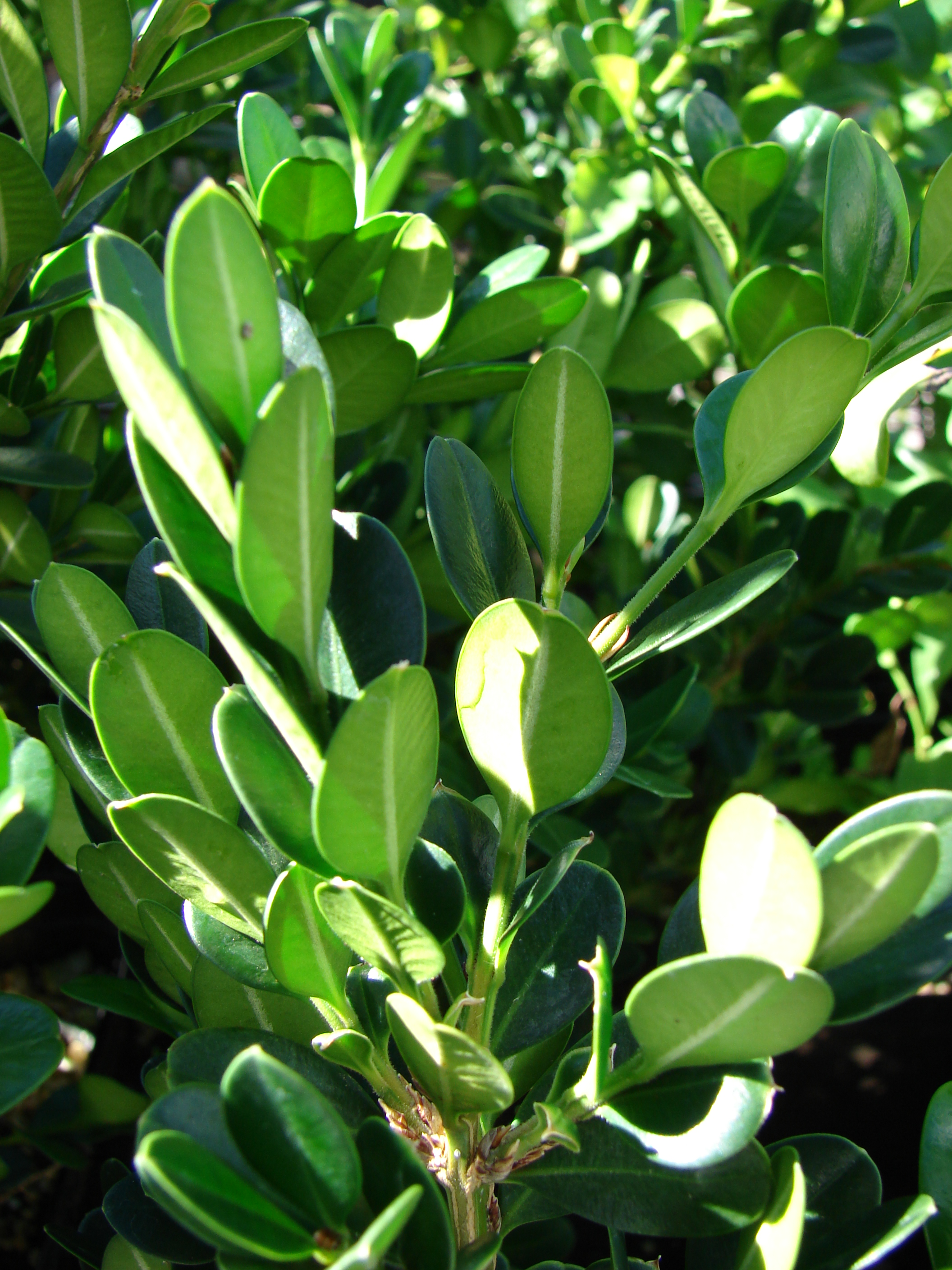


Botanical Name: Buxus sempervirens
Common Name: common boxwood
Family: Buxaceae
Distribution/Origin: Europe
Leaf: notched tip, waxy surfaces, simple, elliptic to ovate, entire margins
Bud: opposite
Flower: perfect, raceme, green to yellow, not showy, bee pollinated
Fruit/Seed: brown capsules, black seeds
Stem/Bark: lightly fissured, multi stemmed trunk, olive to brown in color
Size: 7-10’ height, 7-10’ spread
Habit: dense, upright
Form: rounded
Soil conditions: alkaline, well drained
Moisture: even moisture
Sun: full sun to partial shade
Exposure: can only handle full sun if water levels are consistent
Landscape use: winter interest, hedge, floristry, group or mass planting, hedge row, rock garden, topiary
Notes: leaves turn bronze in cold weather




Botanical Name: Cotoneaster dammeri
Common Name: bearberry cotoneaster
Family: Rosaceae
Distribution/Origin: central southern China, naturalized in Europe
Leaf: simple, leathery texture, glabrous surfaces, entire margins, elliptic to obovate, ovate
Bud: alternate
Flower: solitary, perfect, blooms May-June, white with pink undersides, pretty
Fruit/Seed: red, subglobose pome
Stem/Bark: smooth, lightly fissured, red to brown
Size: up to 1’ height, 5-6’ spread
Habit: spreading, creeping
Form: mat like, irregular, finely branched
Soil conditions: rocky, gravelly
Moisture: moderate
Sun: full sun, partial shade
Exposure:
Landscape use: attracts beneficial insects, erosion control, espalier, fall interest, ground cover, rock garden, winter interest
Notes: susceptible to mites, root rot, scales, roots from branch nodes
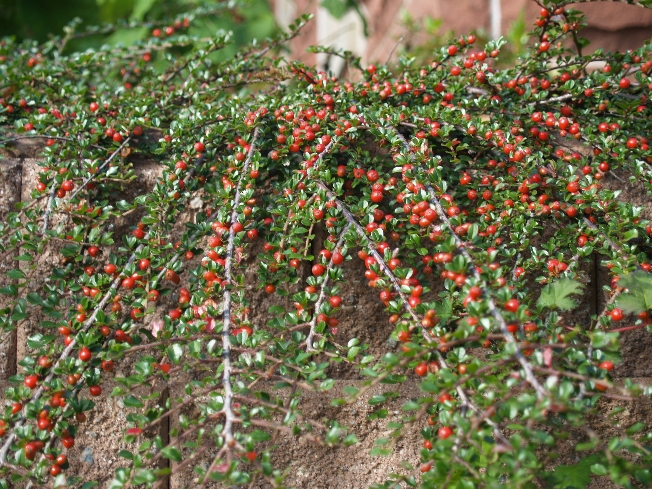

Botanical Name: Cotoneaster franchetii
Common Name: franchetii cotoneaster
Family: Rosaceae
Distribution/Origin: south western China, Tibet and Burma
Leaf: simple, glabrous & pubescent surfaces, elliptic to ovate, entire margin
Bud: alternate
Flower: perfect, cymes of white to pink blooms, July to August
Fruit/Seed: orange, red to dark red pomes
Stem/Bark: smooth olive to brown
Size: 7-10’ height, 4-8’ spread
Habit: upright, arching
Form: oval, horizontal, round
Soil conditions: well drained, moderately fertile
Moisture: dry to moist
Sun: full sun, partial shade
Exposure: tolerant of drought, can withstand poor soils, including rocky
Landscape use: hedge, naturalized areas, attracts birds, group or mass planting, mixed borders, shrub garden, wildlife food, winter interest
Notes: plants have escaped cultivation and have naturalized in areas such as California, Oregon and Washington as a result of birds, mammals, water currents and human activity




Botanical Name: Cotoneaster microphyllus
Common Name: grey cotoneaster, little leaf cotoneaster
Family: Rosaceae
Distribution/Origin: South Asia, India
Leaf: small leaves, simple,
Bud: opposite alternate
Flower: perfect, clustered, pollinated by flies/midges
Fruit/Seed: red pome, not considered edible
Stem/Bark: smooth, brown
Size: 3-5’ height, 3-5’ spread
Habit: dense, spreading
Form: oval, horizontal
Soil conditions: well drained, average, adaptable
Moisture: dry to moist
Sun: full sun to partial shade
Exposure: drought tolerant
Landscape use: container planting, fall interest, group or mass planting, rock garden, winter interest
Notes:




Botanical Name: Cotoneaster salicifolius
Common Name: willow leaves cotoneaster
Family: Rosaceae
Distribution/Origin:
Leaf: pinnate venation, wrinkled appearance, underside pubescent, simple, lanceolate, entire margins
Bud: alternate
Flower: compound corymbs, glabrous surfaces, 5 petalled, entire margins
Fruit/Seed: red pomes
Stem/Bark: smooth grey, thin stems
Size: 7-10’ height, 10-13’ spread
Habit: arching, upright
Form: vase
Soil conditions: well drained, average
Moisture: dry to moist
Sun: full sun to partial shade
Exposure: shelter from cold harsh winds if soil is dry
Landscape use: fall interest, filler, group or mass planting, screening, winter interest, groundcover
Notes: name translates to “leaves like willows”




Botanical Name: Magnolia grandiflora 'Little Gem'
Common Name: southern magnolia
Family: Magnoliaceae
Distribution/Origin: North America
Leaf: simple, entire margins, elliptic to ovate, green, bronze-brown undersides
Bud: alternate
Flower: fragrant, thick petalled, perfect, solitary, 5 petalled
Fruit/Seed: seed pods, fleshy red seeds, aggregate
Stem/Bark: thin, smooth grey
Size: 15-30’ height, 8-12’ spread
Habit: upright, dense
Form: pyramidal
Soil conditions: sandy loams, peaty, well drained
Moisture: moist
Sun: part shade to part sun
Exposure: poor drought and air pollution tolerance, keep sheltered from wind
Landscape use: container, above ground planter, espalier, wide tree lawns, meridians, parking lots, near decks/patios, screen, street tree, residential
Notes:




Botanical Name: Osmanthus x burkwoodii
Common Name: hybrid sweet olive
Family: Oleaceae
Distribution/Origin: garden origin
Leaf: glossy dark green, leathery, slightly serrated, ovate
Bud: opposite
Flower: tubular clusters, white yellow to orange, 4 lobed
Fruit/Seed: drupe, aborted/absent, blue to black
Stem/Bark: lightly fissured, multi stemmed trunk, grey to tan
Size: 7-10’ height, 7-10’ spread
Habit: twiggy
Form: round
Soil conditions: acidic, well drained, average
Moisture: moist to dry
Sun: full sun to partial shade
Exposure: drought tolerant
Landscape use: group or mass planting, mixed shrub border, woodland margin
Notes:

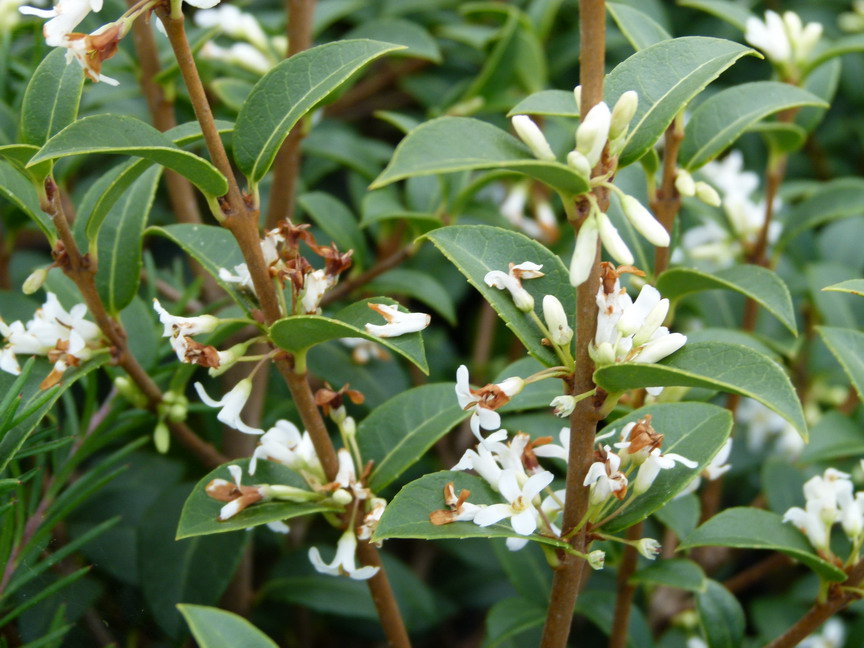
Botanical Name: Osmanthus delavayi
Common Name: delavayi osmanthus, tea olive
Family: Oleaceae
Distribution/Origin: western China
Leaf: small, thick, curved, finely toothed margins, ovate with pinnate venation
Bud: opposite
Flower: tubular clusters, white, fragrant
Fruit/Seed: blue to black drupe
Stem/Bark: multi stemmed trunk, dark grey
Size: 6-10’ height, 6-10’ spread
Habit: arching, dense
Form: round
Soil conditions: alkaline, gravelly, rocky, well drained
Moisture: dry to moist
Sun: full sun
Exposure:
Landscape use: fragrance, rock garden, hedging, screens, banks, slopes, low maintenance
Notes:




Botanical Name: Osmanthus heterophyllus 'Variegatus'
Common Name: variegated holly olive
Family: Oleaceae
Distribution/Origin: eastern Asia, southern Japan
Leaf: variegated, simple, leathery/prickly texture, glabrous, dark/light green with yellow creamy edges, elliptic to ovate
Bud: opposite
Flower: clustered tubular blooms, not showy, fragrant
Fruit/Seed: blue to black drupes
Stem/Bark: tan to brown, spines present
Size: 10-16’ height, 13-16’ spread
Habit: bushy, dense, upright
Form: round
Soil conditions: acidic, well drained, rich
Moisture: low to moderate
Sun: full sun to partial shade
Exposure: drought tolerant once established, can handle heavy clays
Landscape use: container planting, hedge row, mixed shrub border, topiary
Notes: Genus name comes from Greek osme meaning fragrant and anthos meaning flower




Botanical Name: Pachysandra terminalis
Common Name: Japanese spurge
Family: Buxaceae
Distribution/Origin: SE Asia, Japan, China
Leaf: simple, leathery, pinnate venation, obovate with dentate margins
Bud: alternate
Flower: floriferous spike, white, blooms March to April
Fruit/Seed: insignificant
Stem/Bark: green stems
Size: up to 1’ height, 1-2’ spread
Habit: spreading, upright, creeping
Form: mat like
Soil conditions: acidic, well drained
Moisture: moderate moisture
Sun: deep shade, filtered shade, part sun
Exposure: tolerant of rabbit, deer, drought, heavy shade, erosion, clay soils, drought
Landscape use: groundcover, group or mass planting, mixed shrub border, woodland margin
Notes: The specific epithet terminalis means "ending", and refers to the clusters of leaves which appear at the end of the short stems. Foliage may turn yellow in extreme cold.




Botanical Name: Photinia (Stranvaesia) davidiana
Common Name: stranvaesia, Chinese photinia
Family: Rosaceae
Distribution/Origin: western China
Leaf: simple, oblong to oblanceolate, entire margins, dark dull green
Bud: alternate
Flower: compound corymbs, clusters, white
Fruit/Seed: red orbicular pomes
Stem/Bark: smooth brown bark, purple twigs
Size: 10-15’ height, 8-10’ spread
Habit: upright, bushy
Form: mounding
Soil conditions: fertile, humus rich, well drained
Moisture: medium
Sun: full sun to partial shade
Exposure: avoid wet soils
Landscape use: specimen, background evergreen, screen, borders, hedge, walls, fences, slopes
Notes: best fruit production occurs in full sun




Botanical Name: Photinia x fraseri
Common Name: fraser's photinia, red tip, red top
Family: Rosaceae
Distribution/Origin: garden origin
Leaf: leathery, elliptic to oval, dark green, finely serrated margins, new leaves are red
Bud: alternate
Flower: white, small, corymbose panicles, unpleasant aroma
Fruit/Seed: red pome
Stem/Bark: thin, multi stemmed, not showy
Size: 10-15’ height, 10-15’ spread
Habit: upright, bushy, dense
Form: oval
Soil conditions: average, well drained
Moisture: medium
Sun: full sun to partial shade
Exposure: drought tolerant, tolerant of full shade but less flowering will occur, needs good air circulation
Landscape use: borders, woodland garden, hedge, specimen, screen
Notes: prune in spring

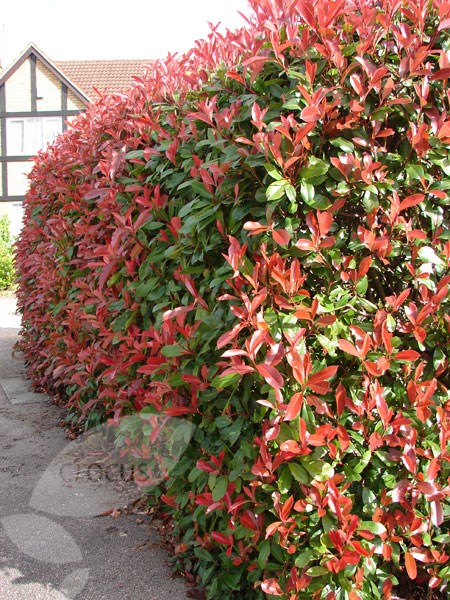

Botanical Name: Rubus rolfei 'Emerald Carpet'
Common Name: creeping raspberry
Family: Rosaceae
Distribution/Origin: garden origin
Leaf: very rugose (wrinkled), simple, lobed, orbicular-ovate, pinnately lobed, undulated margins
Bud: alternate
Flower: solitary, white, not showy
Fruit/Seed: drupe, aggregate of fruit, orange
Stem/Bark: brown, adventitious roots, runners
Size: up to 1’ height, 10-20’ spread
Habit: spreading, creeping
Form: mounding, mat like
Soil conditions: acidic, well drained, average, adaptable
Moisture: average
Sun: full sun to partial shade
Exposure: can handle some drought
Landscape use: beds, borders, slopes, containers, filler, ground cover, erosion control
Notes: roots from stem, spreads quickly




Botanical Name: Sarcococca confusa
Common Name: sweet box
Family: Buxaceae
Distribution/Origin: western China
Leaf: elliptic, tapered tips, glossy green, slightly twisted margins
Bud: alternate
Flower: small white blooms, vanilla scented, insignificant, apetalous
Fruit/Seed: small spherical drupe, black
Stem/Bark: green stems, striped bark
Size: 5-8’ height, 3-4’ spread
Habit: bushy, dense
Form: rounded
Soil conditions: moderately fertile, well drained
Moisture: moist
Sun: full sun to partial shade
Exposure: full sun tolerated when planted in damp soils. Tolerant of dry shade, atmospheric pollution and neglect, thrives in the shade
Landscape use: ground cover, banks, slopes, low maintenance, cottage gardens
Notes:




Botanical Name: Skimmia japonica
Common Name: Japanese skimmia
Family: Rutaceae
Distribution/Origin: SE Asia, China, Japan
Leaf: obovate to elliptic, dark green, leathery, pinnate venation, entire margins
Bud: alternate
Flower: rounded terminal panicles, white to light pink, showy, spicy scent
Fruit/Seed: red drupe
Stem/Bark: smooth brown
Size: 2-5’ height, 3-5’ spread
Habit: spreading, dense
Form: round, mounded
Soil conditions: acidic, well drained, organically rich, fertile
Moisture: high
Sun: deep shade, filtered shade, part shade
Exposure: foliage may scorch in full sun
Landscape use: groundcover, group or mass planting, shaded areas, hedge row, mixed borders, screening, small spaces, spring interest
Notes: female plants typically spread more than male plants, male plants more fragrant with bigger blooms

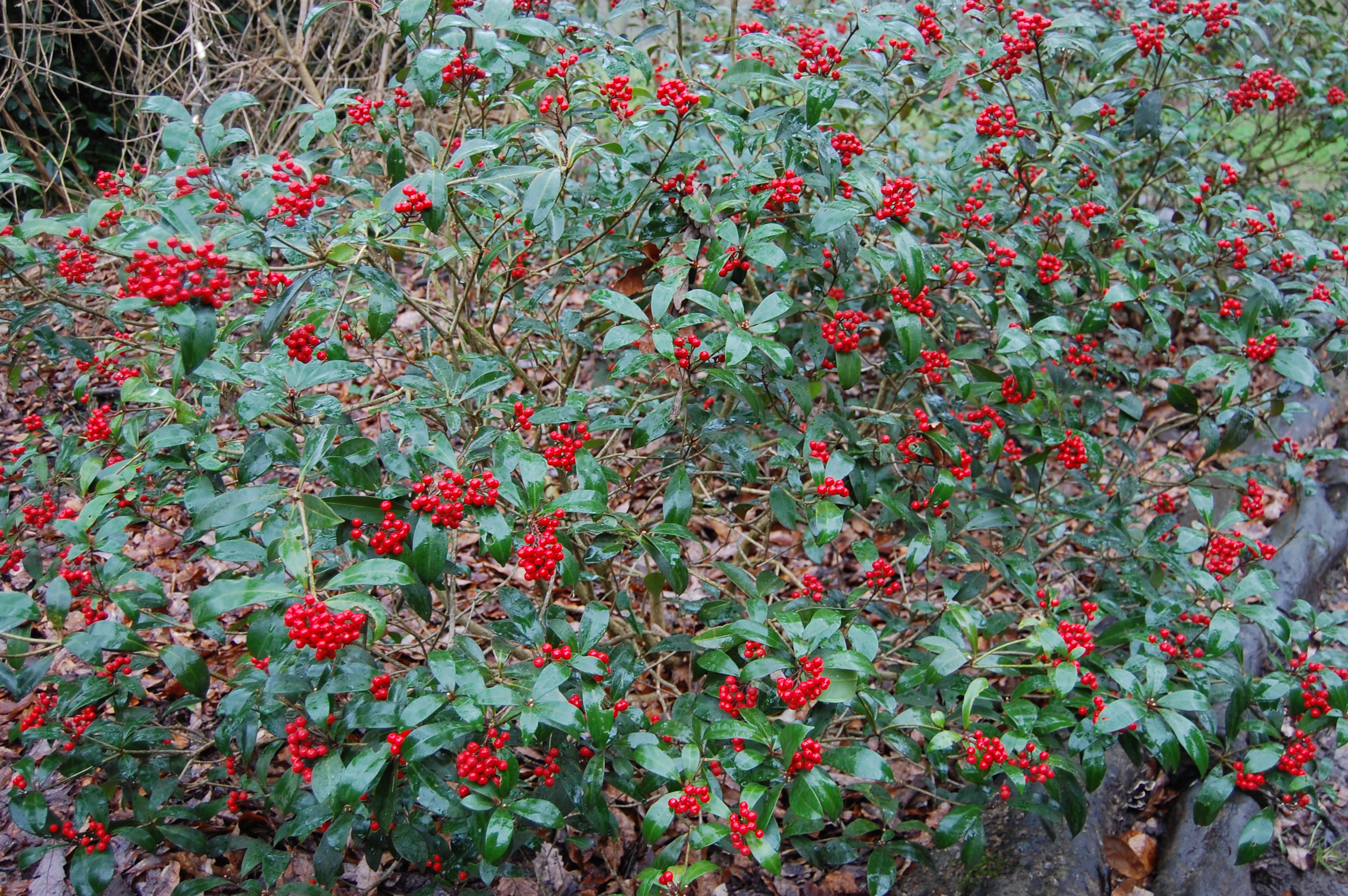


Botanical Name: Yucca filamentosa
Common Name: common yucca, Adam's needle, golden sword yucca
Family: Asparagaceae
Distribution/Origin: SE-eastern US
Leaf: simple, leathery, parallel venation, lanceolate, entire margins, yellow variegation, margins with curly white threads
Bud: basal
Flower: floriferous panicle, perfect, 5 petalled, showy white, scented
Fruit/Seed: brown capsule
Stem/Bark: red to green, usually no above ground stem (flower only)
Size: 1-3’ height, 2-3’ spread
Habit: stiffly upright
Form: round
Soil conditions: rocky, gravelly, sharp drainage
Moisture: dry
Sun: full sun
Exposure: sheltered from winter winds
Landscape use: dry gardens, sunny spots, accent plant, texture, rock gardens
Notes:




Botanical Name: Yucca gloriosa var. recurvifolia
Common Name: curve leaved yucca
Family: Asparagaceae
Distribution/Origin: SE US
Leaf: hard, stiff, narrow, lanceolate, sharp tips (can break skin)
Bud: basal
Flower: floriferous panicle, white creamy blooms
Fruit/Seed: brown capsule
Stem/Bark: thick trunk, multi stemmed,
Size: 6-10’ height, 3-6’ spread
Habit: upright, erect
Form: round
Soil conditions: adaptable, poor/lean to rich, sandy, gritty, dry
Moisture: occasional, low
Sun: full sun
Exposure: heat and drought tolerant, deer resistant
Landscape use: specimen, borders, containers, rock gardens, dry hot areas, accent
Notes: good to trim leaf tips




Botanical Name: Vinca major
Common Name: big leaf periwinkle
Family: Apocynaceae
Distribution/Origin: western Mediterranean
Leaf: orbicular, lanceolate at apex, broad glossy dark green, entire margins, hairy petiole
Bud: opposite
Flower: axillary, solitary, blue to purple, perfect
Fruit/Seed: follicle, aggregate of fruit
Stem/Bark: adventitious roots
Size: up to 10” height, spreading indefinitely
Habit: spreading, creeping
Form: mat like
Soil conditions:
Moisture: moist
Sun: full sun to deep shade
Exposure:
Landscape use: ground cover, slopes, banks, borders, beds, naturalized area, filler
Notes:




Botanical Name: Vinca minor
Common Name: dwarf periwinkle, minor periwinkle
Family: Apocynaceae
Distribution/Origin: Europe, naturalized in North America
Leaf: simple, leathery texture, elliptic to obovate, entire hairy margins
Bud: opposite
Flower: funnel form, perfect, 5 petaled, solitary, purple to blue, blooms Mar-April
Fruit/Seed: follicle, aggregate of fruit
Stem/Bark: adventitious roots, green
Size: less than 1’ height, up to
Habit: spreading, creeping
Form: mat like
Soil conditions: acidic, well drained, adaptable
Moisture: low
Sun: filtered shade, full sun
Exposure:
Landscape use: groundcover,
Notes: the color periwinkle is derived from the flower 

Grab your plants at Photinia Super Hedge | Photinia Robusta for Sale
ReplyDeletePictures are great. Bird of Paradise Plant | Strelitzia Reginae
ReplyDelete